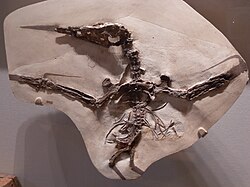| Nyctosaurus Temporal range:
| |
|---|---|

| |
| Fossil specimen (CM 11422) of Nyctosaurus gracilis in the Carnegie Museum of Natural History | |
| Scientific classification | |
| Domain: | Eukaryota |
| Kingdom: | Animalia |
| Phylum: | Chordata |
| Order: | †Pterosauria |
| Suborder: | †Pterodactyloidea |
| Family: | †Nyctosauridae |
| Genus: | †Nyctosaurus Marsh, 1876 |
| Type species | |
| †Nyctosaurus gracilis Marsh, 1876
| |
| Species | |
| |
| Synonyms | |
|
Genus synonymy
Synonyms of N. gracilis
Synonyms of N. nanus
| |
Nyctosaurus (meaning "night lizard" or "bat lizard") is a genus of nyctosaurid pterosaur from the Late Cretaceous period of what is now the Niobrara Formation of the mid-western United States, which, during the time Nyctosaurus was alive, was covered in an extensive shallow sea. Some remains belonging to a possible Nyctosaurus species called "N." lamegoi have been found in Brazil, though it likely belongs to a different genus Simurghia. The genus Nyctosaurus has had numerous species referred to it, though how many of these may actually be valid requires further study. At least one species possessed an extraordinarily large antler-like cranial crest.[2]
Nyctosaurus was a mid-sized pterosaur that lived along the shores of the Niobrara Formation of the United States, which back then was within a large inland sea called the Western Interior Seaway. It has been suggested that it would have flown similar to modern-day soaring birds such as albatrosses, which consisted of flying very long distances and rarely flapping.[3] The species N. gracilis and N. nanus have previously been considered as species of the closely related Pteranodon, back then known as P. gracilis and P. nanus, due to their similarities.
- ^ Hone, David; Witton, Mark; Martill, David (2018). New Perspectives on Pterosaur Paleobiology. London: The Geological Society. p. 213. ISBN 978-1-78620-317-5.
- ^ Cite error: The named reference
benett2003was invoked but never defined (see the help page). - ^ Cite error: The named reference
xingetal2009was invoked but never defined (see the help page).